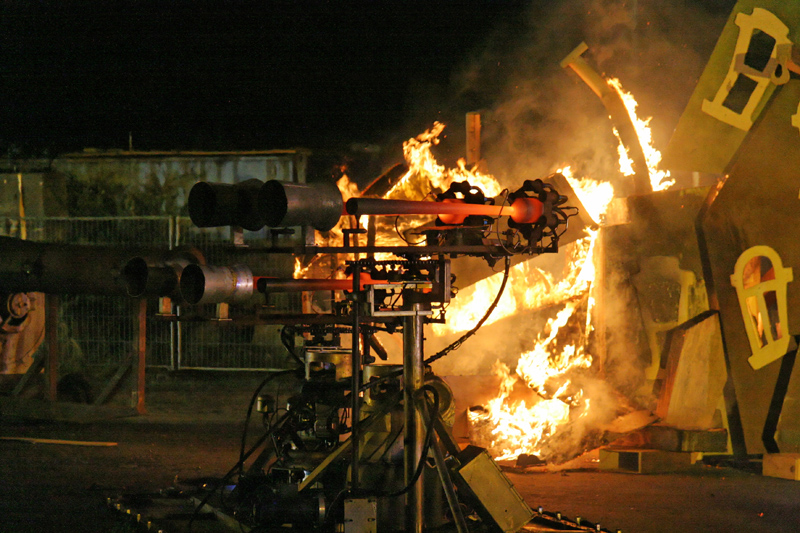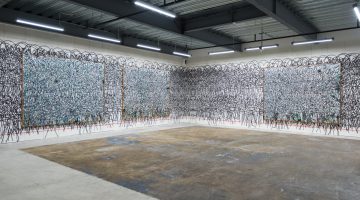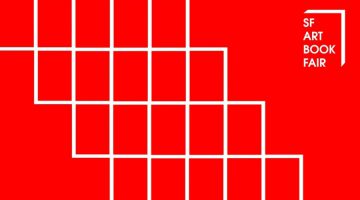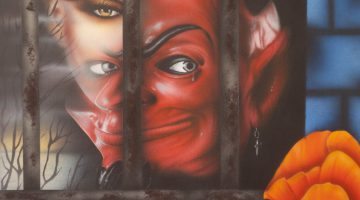Mark Pauline, founder of the Bay Area’s legendary Survival Research Laboratories (SRL), houses his impressive personal archive, robotics workshop, and business in a garage in a non-descript industrial section of Petaluma. Hulking CNC machines, boxes of tools and equipment, and half-built machines populate this former auto detailing shop. The large parking lot out front allows him to test and maneuver his epic machines (sometimes to the chagrin of his neighbors). For decades, Pauline has dedicated his career to building dangerous, elaborate robots for his performances. A commentary on the military industrial complex—the development of which is a determining force in the Bay Area’s own history—as much as a dystopian vision for a post-apocalyptic future, SRL’s acclaimed shows push experiential and technological boundaries.
Pauline’s practice reflects a kind of resilient integrity; his work grew over the years outside of the constraints of the mainstream art market and without much institutional support. A pioneer in the recycling and reselling of biotech equipment, he’s been, in large part, able to support his art through his business, which also provides him with additional materials. His corporate sounding persona “Survival Research Laboratories”—a name he pulled from a 1970s issue of the mercenary magazine Solider of Fortune—captures the critical ethos of his work. Building from detritus, waste, and cast-offs from the military and tech industries (particularly those in the Bay Area), his work illuminates a deep unease with these powerful developments and how one might exist with and after them. The risk on display in an SRL show is never a mere spectacle or entertainment, but rather a confrontation with the destructive capacity of human invention.
The first SRL robot ever built was The De-Manufacturing Machine in 1979. Installed at a gas station during the oil crisis, the machine puréed and flung dead pigeons dressed as OAPEC dignitaries into the audience. Shock, disgust, and fear have always been part of Pauline’s performances. An early video with the industrial music group Factrix features one of his pieces—a suspended pig carcass animated by flailing robotic arms and metal bars, being disfigured on stage by a dentist’s drill. The industrial music scene in San Francisco yielded a space for interdisciplinary experimentation and transgression, in response to Reagan-era discord and conservatism; SRL was initiated within this community, and its attitude carries through in the work.
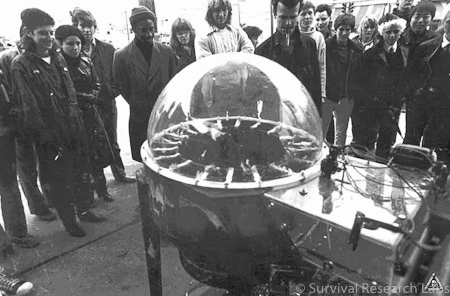
First SRL performance at the Chevron station on Columbus & Green where the De-Manufacturing machine ‘processed’ dead pigeons dressed as Arabs. Courtesy of Mark Pauline.
In an interview for the 1983 RE/Search No. 6/7: Industrial Culture Handbook, Pauline describes the early days of SRL, where he scavenged and stole material for his works from junkyards and factories to stage performances, often in parking lots and warehouses. He talks about his interventions as a process of: “Taking equipment and remanufacturing it, turning it against its engineer’s better wishes. Making things out of it, it was never intended to do.”1 These efforts reassemble and redirect, taking apart tools and equipment towards a different end. But Pauline’s robotic creations have been highly innovative over the years as well. For the 1997 performance Increasing the Latent Period in a System of Remote Destructibility at the InterCommunication Center in Tokyo and SRL’s studio in San Francisco, Pauline, along with Eric Paulos and Karen Marcelo, created the very first firing system operated by users over the web. Three machines—one in San Francisco and two in Tokyo—were operable by online users using free software. Participants controlled the movements of the Track Robot, whose arm pressed buttons on the Epileptic Bot at the ICC, which then sent commands over the Internet to the Air Launcher in San Francisco hitting a range of exploding targets. That same year, SRL also produced a live online stream of video and audio wirelessly from a performance in Austin, Texas entitled The Unexpected Destruction of Elaborately Engineered Artifacts. In order to carry out this early instance of video livestreaming using wireless technology, volunteers built a 60-foot tower that brought Internet connectivity over a microwave wireless network to the show’s site at the Longhorn Speedway. Other pioneering moments are more playful. For instance, in the 1980s, Pauline created the Stu Walker, which was operated by his pet guinea pig Stu, and probably the first animal-controlled robot in performance. A video from a 1985 performance at the Area Nightclub in New York shows the Stu Walker in action, where the spider-like construction awkwardly creeps across the floor and shoots flames in accordance with the guinea pig’s movements.
While Pauline is always building and repairing his cadre of machines, he’s currently developing two new robots. The Motoman Flamethrower mounts a lightweight flamethrower capable of generating a 20-foot flame on a robotic arm known as the Motoman UP50, a popular device for automating assembly lines. Another, as-yet-untitled robot, balances on a single wheel while maneuvering a large arm; it is the first single wheeled robot Pauline has come across in his research. 2016 also brought other major breakthroughs. In April, in conjunction with CAPITAL’s Black Standard exhibit at Minnesota Street Project, Pauline staged one of his first legal public performances in the city in years. He felt that the San Francisco Entertainment Commission understood his work as an artist for the first time, after they issued all the proper licensing permits for the April event. This is after San Francisco had practically banned all SRL performances, a major obstacle and one that Pauline brandished as a badge of honor for some time. If he can find the financial support, he’s hoping to stage another San Francisco performance in the near future, bringing his difficult, commanding performances to more audiences, once again.
